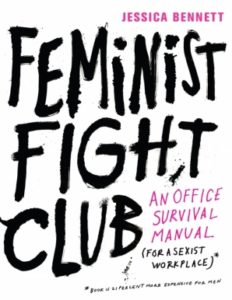A review of ‘Feminist Fight Club: An Office Survival Manual (For a Sexist Workplace)’ By Jessica Bennett
Review by: Rebecca DeRosa

I felt like I was in a time machine, observing the obvious gender bias of a few decades ago and the more subtle discrimination American women face today. As I watched the Amazon original series, Good Girls Revolt, and read Feminist Fight Club, I marveled at how far we have come in the past 46 years.
Good Girls Revolt follows the women who worked at News of the Week (a stand-in for Newsweek) in the months leading up to the complaint of gender-based discrimination that they file with the Equal Employment Opportunity Commission in 1970.
Before 1970, the women at Newsweek were relegated to “helper jobs” such as researcher. Their main function was to prop up the male writers in the office: fact checking their stories and finding sources, typing up reports (that the writers would often “borrow” from verbatim), making their coffee, and massaging their egos.
But the women were never allowed to have a byline of their own and were often paid a third of what the men were paid—even though they worked just as hard. They were told in no uncertain terms, “women don’t write.”
In the show, the women’s lawyer from the ACLU, Eleanor Holmes Norton (also her name in real life), digs up the credentials of everyone in the office and reads them aloud. Most of the women graduated with high marks and honors from Seven Sisters colleges (please note that Princeton and Yale only began accepting female undergraduates in 1969). Many of the men had mediocre education and experience and yet were way ahead of them professionally.
The women wanted to have an opportunity to advance and to earn enough money to support themselves so that they could be independent. They wanted their minds to be valued—they didn’t always want to be the nurturer or the eye candy. This is true today.
However, how far have we come really? The recent allegations again Roger Ailes, the former CEO of Fox News; the class action lawsuit against McDonald’s (a report finds that 40% of fast food workers are sexually harassed), the gender bias in Hollywood, and the many reports of abuse of military service members is a sobering reminder that discrimination hasn’t magically gone away.
 Jessica Bennett, author of Feminist Fight Club, also worked at Newsweek. In fact, her frustrations with office culture and the insidious ways that sexism persists led to her writing the book.
Jessica Bennett, author of Feminist Fight Club, also worked at Newsweek. In fact, her frustrations with office culture and the insidious ways that sexism persists led to her writing the book.
As a young reporter, she discovered the landmark lawsuit that had taken place at the very place she worked. In 2010 she wrote about the case and described the lack of equality that still existed. She points out that the previous year, 2009, only 6 of the 49 Newsweek cover stories were written by women. She noticed her male colleagues climbing up the ladder faster than her and getting the cushier assignments. Most of upper management were white males and she often found herself pitching stories to rooms full of men.
In Feminist Fight Club: An Office Survival Manual (For a Sexist Workplace), Jessica Bennett points out all the different ways women are discriminated against in offices today. This can take many forms: interrupting women in meetings, stealing their ideas, asking them to make coffee, take notes, or plan parties (and never asking men to do these things), and not inviting women to outings that take place at strip clubs and golf courses. This may not sound as bad as say, a boss exposing himself to his subordinate or telling her that “women don’t write.” But they do take their toll. This is the kind of subtle sexism, full of micro aggressions, that holds women back professionally—and are harder to lodge formal complaints against.
Feminist Fight Club is laid out in a fun, inviting way with snappy new terms like “manterrupter” and “lacthater.” This makes it easier to digest some pretty indigestible facts about how women are undermined in subtle, yet toxic, ways.
By speaking about these issues and giving them a name, Bennett says she hopes that women and men will be able to change their behaviors to make the workplace more egalitarian. Companies will benefit from utilizing the talents of all the employees regardless of gender, race, age, etc.

She offers concrete examples of how a woman can word things to come off as stronger and more assertive—when accepting praise or bringing attention to her own hard work and superb ideas, for example.
Throughout, Bennett urges women to band together and to back up each other’s ideas instead of competing with one another. As she proclaims in bold text:
This is not a solo task.
We need women by our side.
So let’s start by linking arms.


